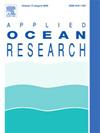Estimation of moored ship motions using a combination of machine learning techniques
IF 4.3
2区 工程技术
Q1 ENGINEERING, OCEAN
引用次数: 0
Abstract
The moored ship motions can cause problems for the efficiency of the operation, and for the people and equipment involved. Therefore, being able to predict movements and anticipate possible risk situations is of great interest to operators and the port community. This work presents a methodology applying different machine learning techniques that has allowed positive results to be obtained for this objective, with particular emphasis on the highest values (outliers), which are usually associated with problematic situations. The field campaigns carried out allowed 77 different vessels to be monitored in the outer port of A Coruña (Spain). The techniques used were gradient boosting (GBM), a neural network (DNN), a quantile regression (qReg) and several models generated by stacking (GBM*). The results indicate a lower root mean square error (RMSE) with the use of the latter technique (the validation on the swell is 0.13 m, while the DNN is twice as high), and a better performance on most motions in the outlier subset than those obtained with the individual models (the validation on the outlier subset for the pitch gives an RMSE of 0.12° and 0.2 for the GBM). Finally, the results show that this methodology can be extrapolated to other ports.
利用机器学习技术组合估算停泊船只的运动
停泊船只的运动会给作业效率以及相关人员和设备带来问题。因此,能够预测船舶运动并预测可能出现的风险情况是运营商和港口界非常关心的问题。这项工作介绍了一种应用不同机器学习技术的方法,该方法可在实现这一目标方面取得积极成果,尤其侧重于通常与问题情况相关的最高值(异常值)。通过实地考察,对西班牙科鲁尼亚外港的 77 艘不同船只进行了监测。使用的技术包括梯度提升(GBM)、神经网络(DNN)、量子回归(qReg)以及通过堆叠生成的多个模型(GBM*)。结果表明,使用后一种技术的均方根误差(RMSE)较低(对涌浪的验证为 0.13 米,而 DNN 的均方根误差是前者的两倍),对离群子集中大多数运动的性能也优于使用单个模型所获得的性能(对离群子集的验证,俯仰的均方根误差为 0.12°,而 GBM 的均方根误差为 0.2)。最后,结果表明这种方法可以推广到其他港口。
本文章由计算机程序翻译,如有差异,请以英文原文为准。
求助全文
约1分钟内获得全文
求助全文
来源期刊

Applied Ocean Research
地学-工程:大洋
CiteScore
8.70
自引率
7.00%
发文量
316
审稿时长
59 days
期刊介绍:
The aim of Applied Ocean Research is to encourage the submission of papers that advance the state of knowledge in a range of topics relevant to ocean engineering.
 求助内容:
求助内容: 应助结果提醒方式:
应助结果提醒方式:


